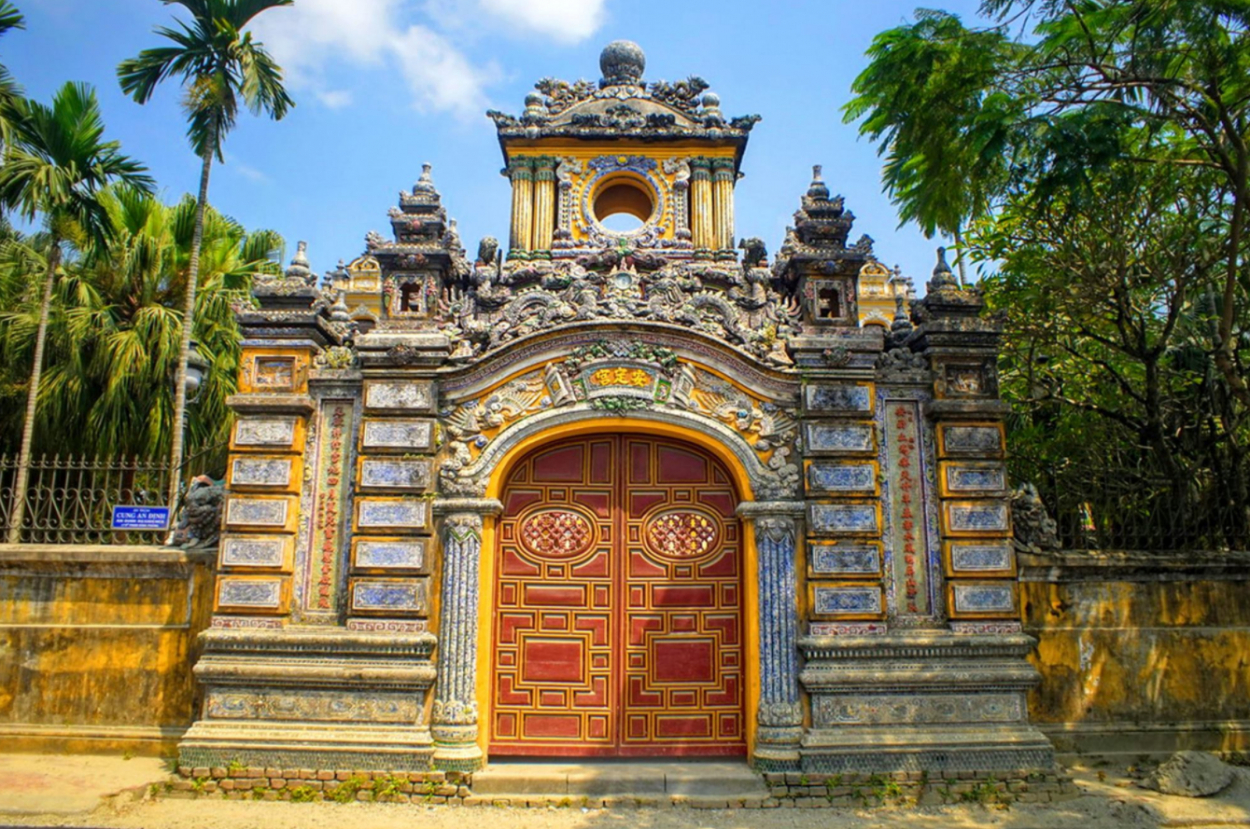An Dinh Palace faces south, towards the An Cuu River. The palace has a flat terrain, a total area of 23.463m2, surrounded by a brick wall, 0,5m thick, 1,8m high with a fence. When the palace is still intact, there are about 10 structures. From front to back are: Marina, Main Gate, Trung Lap Bower, Khai Tuong Pavillion, Cuu Tu Dai Theater, Animal Cages, Lake... Through the passage of time and the devastation of the war, up to now, only 3 fairly intact structures remain the Main Gate, Trung Lap Bower, and Khai Tuong Pavilion. The main gate is made in the design of three-arched gate, two-storey, decorated with very elaborate embossed porcelain. Trung Lap Bower, located inside the door, has an octagonal structure with a high base. Inside, there is a bronze statue of King Khai Dinh, in real-life proportions, cast in 1920.

Khai Tuong Pavilion is the main structure of An Dinh Palace. The word Khai Tuong (meaning where the good omens start), the name of the Pavillion, is set by Emperor Khai Dinh. The 3-storey floor, built with new materials in the style of a European castle, occupies an area of up to 745m2. The floor is very ornately decorated, especially the interior of the First floor with murals of high artistic value.
Prominent in this hall are 6 decorative paintings on the wall panels, with wooden frames bordered, carved apricot flowers, and very beautiful stylized lotus leaves. These six paintings are not named, but when looking at the drawing, viewers can easily identify that it is the real perspective of 5 mausoleums: Gia Long, Minh Mang, Thieu Tri, Tu Duc, Dong Khanh; Particularly the 6th picture (from the inside out) is not clear of which works. It is suggested that this can be Khai Dinh mausoleum when in the form of sketches on the drawing, and the painting is not the same as Khai Dinh mausoleum today because, after the trip to France (1920), Khai Dinh emperor changed the design of the mausoleum in the Western style, so it is no longer the same as the painted picture. All six paintings do not have the artist's signature, so the identification of the authors of the six paintings still has many different opinions. In 2003, when restoring these six paintings, researchers discovered in the corner of one of the six paintings signed Nguyen Van Ngoan (or Ngoãn).
Compared to other architectures of the same period, An Dinh Palace is a superficial project that was started and completed at the earliest. At the beginning of the period when Hue art history was exposed and influenced by the West, An Dinh Palace also created its characteristics when harmoniously combining traditional decorative themes such as four spirits, four quarters, eight decorations, stylized patterns with Roman style column decorations, or angels... in European style. All the large and small structures in An Dinh Palace have a close relationship with each other in a meaningful harmonious way to create a private, quiet, but friendly architectural picture in the heart of Hue city.
In 2001, An Dinh Palace was restored and became one of the venues for the Hue Festival 2002. In 2003, the German Embassy donated 17.000 euros to restore six rare murals in the interior of the Khai Tuong Pavillion. By means of modern techniques, German relic restoration experts have studied, analyzed, and restored the paintings... Thanks to that, the luxurious and splendid interior of Khai Tuong Pavillion, as it used to be in the early twentieth century, gradually appeared. On the occasion of Hue Festival, An Dinh Palace is always one of the important places where art performances and exhibitions of antiques take place. Attracting a large number of tourists to visit Hue, contributes significantly to the success of Hue Festivals. Along with other architectural works in Khai Dinh period, such as Khai Dinh Mausoleum, Kien Trung Pallivion, Hien Nhon Gate... An Dinh Palace is considered a typical representative of Vietnamese architectural style in the Neo - Classique period.
